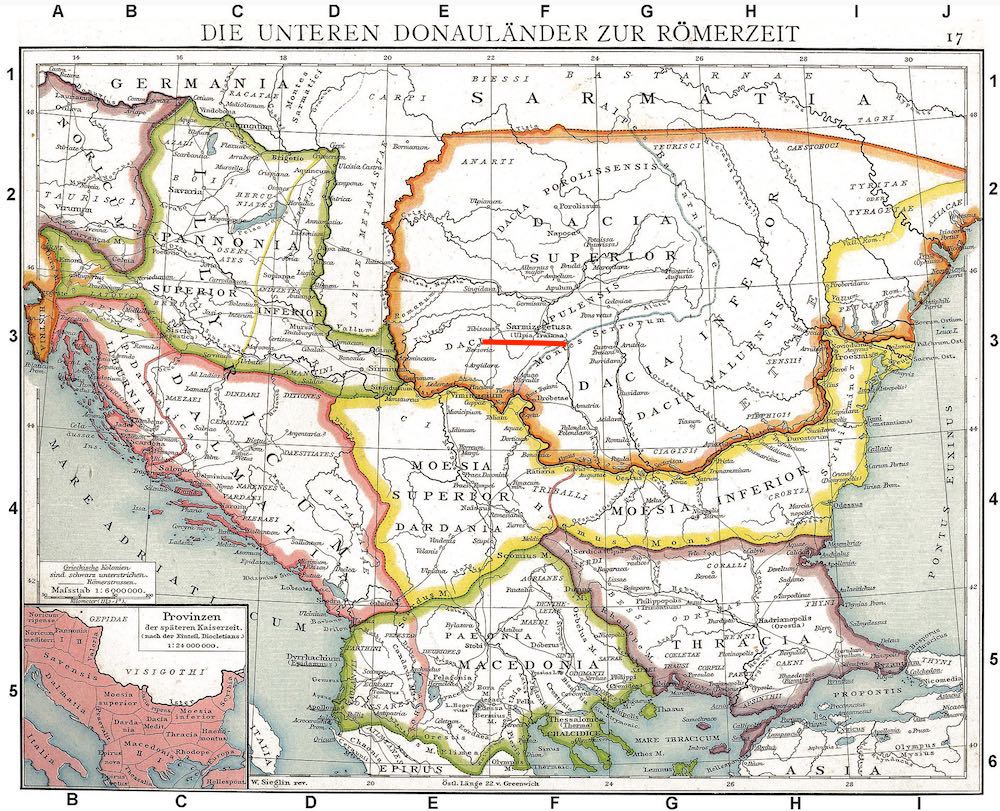 Coins of Trajan, Roman emperor 98-117 CE, that relate to particular historical events--especially his conquest of Dacia in 106.
Coins of Trajan, Roman emperor 98-117 CE, that relate to particular historical events--especially his conquest of Dacia in 106.
Trajan added Dacia to the Roman empire as a province. It is the upper-right region in orange on the map (by Gustav Droysen, 1838-1908). It has the Danube River as its southern boundary. Its capitol, Sarmizegetusa, is underlined in red.
Many Roman coin types refer to his Dacian victories and annexation of the region. This page illustrates some of Trajan's historcial types.
What's new? 2021, June 22: Trajan drachm from Bostra.
2020, Sept. 29: Tetradrachm and drachm celebrating Trajan's annexation of Arabia.
Trajan's Coins. Trajan issued many reverse types that referred to particular historical events, including these events (with the event date in parentheses):
1) Rebuilding the Circus Maximus (103)
2) Annexing Arabia (ARAB ADQVIS, 106)
3) The Dacian wars (many types next, 101-102 and 105-106)
4) Supporting poor children (Alimenta Italia, 108)
5) Building an aqueduct (AQVA TRAIANA, 109)
6) Building a road (VIA TRAIANA, 109)
7) Building near the forum (FORVM TRAIANI, BASILICA VLPIA, 112)
8) Parthian war (many types, 113-117)
Dacian Wars. His Dacian victories were especially consequential because they led to a rich (with gold mines) new province being created and added to the empire. Dacia remained a Roman province over 160 years, until c. 275 when it was abandoned by Aurelian after it had been under great pressure from Goths and Carpi over the previous 25 years.
The history of the two wars was written by Cassius Dio c. 229 CE and illustrated by Trajan's column, completed in 113, still extant in Rome (however, the original statue of Trajan at the top has been replaced by a statue of St. Peter).
Here is a denarius with Trajan's column:

Denarius. 20-18 mm. Struck 116.
SPQR OPTIMO PRINCIPI
The Senate and the People of Rome, Best Prince
Trajan's column, eagles at base, statue of Trajan on top.
RIC 292 "114-117". Sear II 3151v "116"
Wikipedia has an article on the amazing column.
The first Dacian war in 101-2 resulted in a Roman victory and a settlement leaving the Dacian king Decebalus in place with various obligations to Rome. Instead of fulfilling them he rebuilt his capability of resistence which provoked the second Dacian War. The capitol was besieged and destroyed and Decebalus, rather than be captured, committed suicide. He had hidden much of the precious metal of Dacia beneath the river Sargesia/Sargetia, but a Dacian betrayed its location and it was recovered by the Romans. Wipipedia says Carcopino estimated it at 165,500 kg of gold and 331,000 kg of silver, although I don't think such precise numbers could be justifed. Regardless, it was a huge amount of money.
Victories are one thing; successfully conquering territory and incorporating it into the empire is quite another. Trajan had victories against the Germans along the Rhine in 98-99 and received a triumph, but territory did not change rulers. In contrast, the Dacian victories resulted in the death of the king of the Dacians and a new province across the Danube (a.k.a. Ister) which had not been Roman before. A sestertius type shows a peaceful scene.
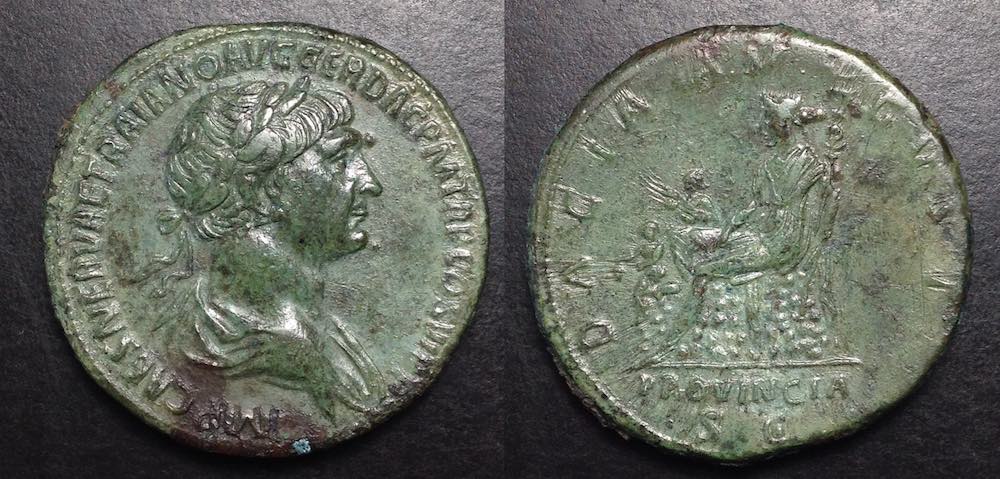
Sestertius. Large. 33-32 mm. 27.24 grams.
Bust of Trajan right, with long legend including numerous titles:
IMP CAES NERVAE TRAIANO AVG GER DAC PM TRP COS VI PP
Struck 112-114.
DACIA AVGVST PROVINCIA, SC below
Dacia seated left on rocks, holding legionary eagle in left, with child holding bunch of grapes at her feet and a child holding two ears of grain behind her right knee.
RIC 621. Sear II 3183.
This type explicitly celebrates the new province of Dacia. The tiny figures show its agricultural wealth in wine and grain. Its accumulated wealth and gold mines were even more important.
In order to have easy access to the far side of the Danube, a very broad river except for narrower gorges with rapids, Trajan constructed a huge masonry bridge with 20 pilings and arches each spanning 175 feet each between them (according to Cassius Dio). One such span is shown on a sestertius (not illustrated here). He also issued a type with the river god that explicitly names the Danube.
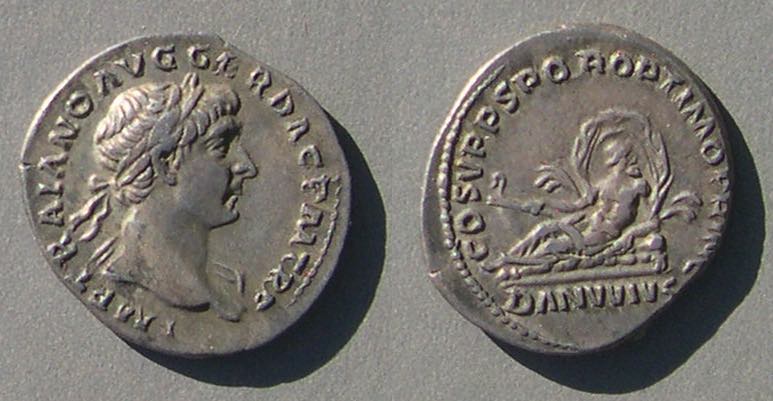 Trajan. Denarius.
Trajan. Denarius.
Denarius. 19-18 mm. 3.09 grams.
IMP TRAIANO AVG GER DAC PM TRP
Laureate head right
COS V PP SPQR OPTIMO PRINC
DANVVIVS below river god reclining left, head right, cloak floating above, his right hand rests on a ship's prow and his left elbow on a tipped urn from which flows water.
RIC 100. Struck 107-111. Sear II 3138.
DAC in the obverse legend shows this was minted after he was awarded the title Dacicus.
DAC CAP. "Dacia capta" (Dacia captured) is part of the reverse legend on several types.

Trajan, laureate bust right with slight drapery on shoulders
Denarius. 18 mm.
COS V PP SPQR OPTIMO PRINC
DAC CAP in exergue
RIC 96. Sear II 3136. Hill 482, struck 108.
Captured Dacian warrior in trousers (not used by Romans)
hands tied behind his back, on pile of arms with shields, spears, and curved Dacian weapons.

Trajan, laureate bust right with slight drapery on shoulders
Denarius. 19-18 mm.
COS V PP SPQR OPTIMO PRINC
DAC CAP in exergue
RIC 99. Sear II 3137. Hill 493, struck 109.
Dacian warrior standing, hands tied in front
arms around including shields and a spear.

Trajan, laureate bust right with slight drapery on shoulders.
Denarius. 19-18 mm.
COS V PP SPQR OPTIMO PRINC
DAC CAP in exergue
RIC 98. Sear II 3136. Hill 496, struck 110.
Trajan, Dacia personified, captive, seated left in dejected pose, on pile of arms including shields, spears, and curved Dacian weapons.
 Trajan, laureate bust right with slight drapery on shoulders.
Trajan, laureate bust right with slight drapery on shoulders.
Denarius. 20-18 mm.
COS V PP SPQR OPTIMO PRINC
RIC 130. Sear II 3128. Hill 525, struck 111.
Victory standing right inscribing DA/CI/CA on shield on a column.
These types and others are also on other denominations.
Some of Trajan's other historical types are discussed next.
ALIM ITAL. He formalized an alimenta, a welfare program that helped orphans and poor children throughout Italy. It provided general funds, as well as food and subsidized education. The program was supported initially out of Dacian War booty, and then later by a combination of estate taxes and philanthropy (according to Wikipedia).
 Trajan, laureate bust right with slight drapery on shoulders
Trajan, laureate bust right with slight drapery on shoulders
Denarius. 20-18 mm.
SPQR OPTIMO PRINCIPI
ALIM ITAL in exergue
Annona standing, holding cornucopia in left, wheat ears in right, small child standing at left.
RIC 243. Sear II 3117. Hill 578 "113."
VIA TRAIANA. The Via Traiana was a road built by Trajan as an extension of the Via Appia cutting across Italy at Beneventum, northeast of Neopolis, reaching Brundisium (Brindisi) by a shorter route along the east coast.
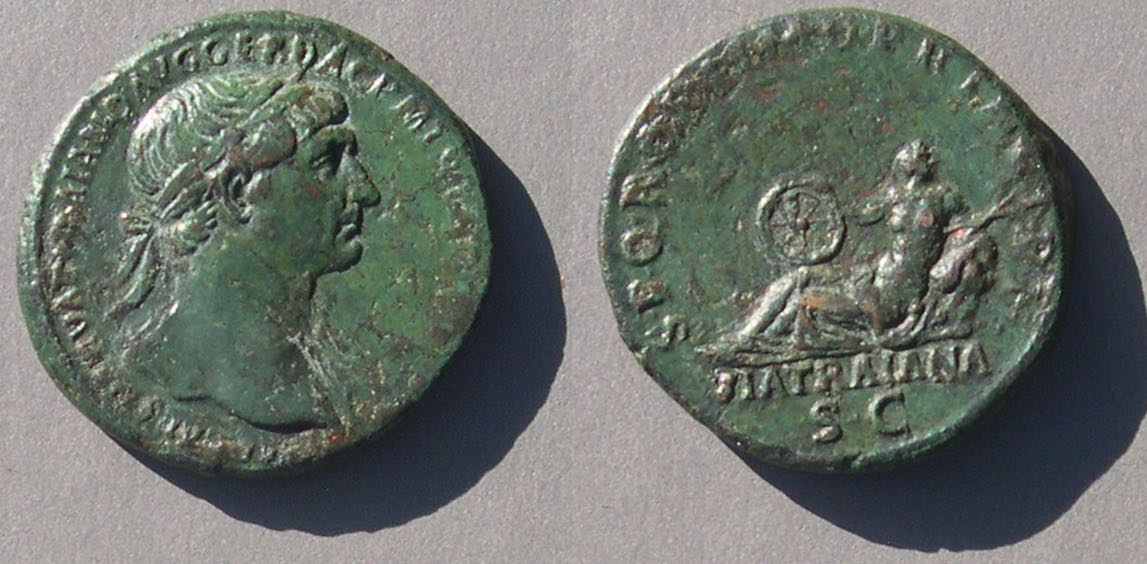 Trajan, laureate bust right with slight drapery on far shoulder
Trajan, laureate bust right with slight drapery on far shoulder
As. 27 mm.
SPQR OPTIMO PRINCIPI
VIA TRAIANA, SC in exergue
Via Trajana reclining left, head right, holding wheel on right knee, resting left elbow on rocks and holding branch in left arm.
RIC 639. Sear II 3226v (this reverse on a dupondius). Hill 589 "113."
ARAB ADQVIS. Roman Arabia, where Jordan is now, had its capitol at Petra under the Nabateans and controlled trade routes across the Arabian peninsula. When the Nabataean King Rabel II died, Trajan annexed it in 106 without bloodshed and made Bostra the capitol.
 Trajan, laureate bust right with slight drapery on far shoulder
Trajan, laureate bust right with slight drapery on far shoulder
Denarius. 19 mm.
SPQR OPTIMO PRINCIPI
ARAB ADQV in exergue
Arabia standing left, holding branch and bundle of canes, forepart of camel to left
[It is not an ostrich. Some aurei show all four legs clearly.]
RIC 245. Sear II 3118. Hill 579 "113."
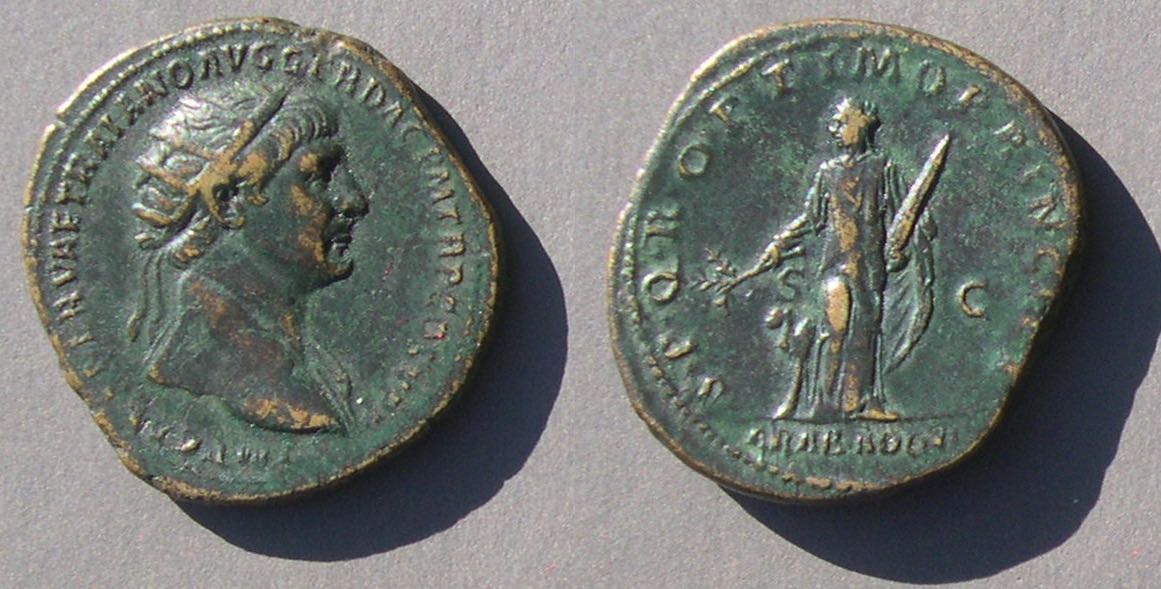
28-26 mm. 11.46 grams.
as above, but a radiate dupondius, with
ARAB ADQVI
RIC 613. Sear II -- (type of the denarius above). Hill 515 "111."
Silver for Arabia. Trajan struck drachms and tetradrachms celebrating Arabia. The style of the next two is so good that some scholars think the dies were engraved at Rome. If the coins were not struck at Rome, the dies may have been sent to Tyre or the capitol of Arabia, Bostra, and the coins struck there.
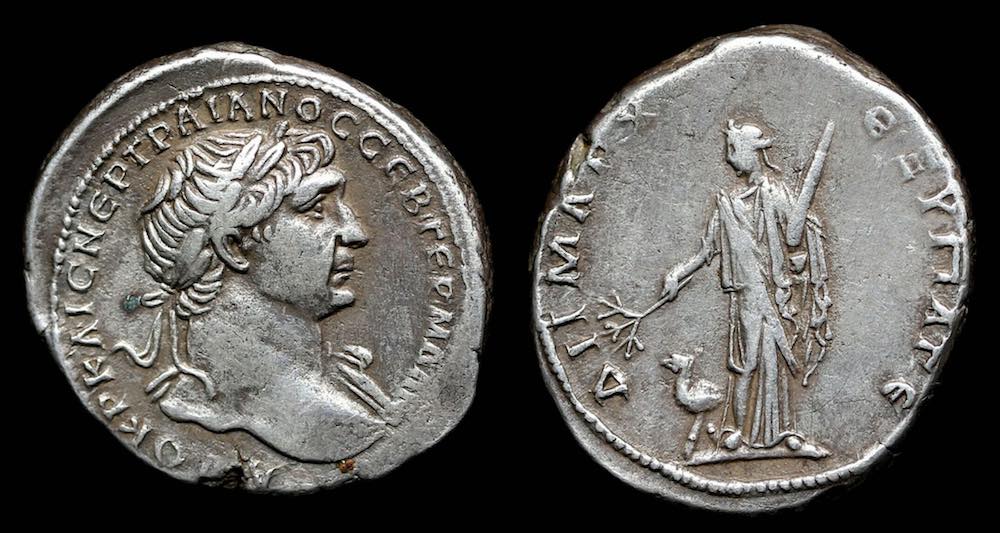 Trajan as COS V, struck c. 110-114
Trajan as COS V, struck c. 110-114
25-23 mm. 10.65 grams.
This denomination is often called a "tridrachm" for its low weight compared to other tetradrachms, but PRC says the silver alloy is distinctly better such that the total silver in it makes it a tetradrachm.
AVTOP KAIC NЄP TRAIANOC CЄB ΓЄRM ΔAK
Laureate head right, drapery on far shoulder.
ΔHMAPX ЄΞYΠAT Є
Arabia standing left holding out branch and holding up bunch of cinnamon sticks, camel to left at feet (The rear legs are rarely depicted, but all four legs show on some aurei with this type.)
McAlee page 194 "type C, light tetradrachm" notes it may have been struck at Tyre for use in Arabia or the dies may have been cut in Tyre for use in Arabia.
RPC III 4051/4058, Arabia, plate 179. "Probably made in Rome and Antioch (or at least the dies were made there) c. 110-114. "Silver content equal to the Syrian tetradrachms."
SNG ANS VI 1153 Bostra, plate 39. W. Metcalf wrote an article noting they are found in Israel and should not be attributed to Cappadocia as had been previously thought. There are drachms with the same reverse type, however with portrait in the style of Antioch tetradrachms (not illustrated here). The next drachm is in Roman style. Woytek and Butcher argue it was minted in Rome.
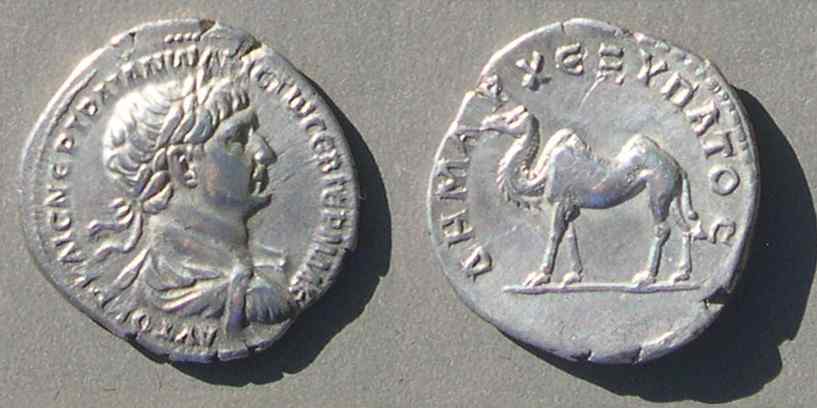 Trajan. Struck 114-early 116.
Trajan. Struck 114-early 116.
Drachm. 19 mm. 3.33 grams.
AVTOP KAIC NЄP TRAIANOC APICTω CЄB ΓЄRM ΔAK
APICTω = OPTIMO, a title he received in 114.
Bust right, laureate, draped and cuirassed.
ΔHMAPX ЄΞ YΠAT C
Two-humped (Baktrian) camel left
SNG von Aulock III 6408 (Caesarea in Cappadocia, now thought to be incorrect).
SNG ANS VI 1158 "Bostra" (capitol of the province of Arabia).
McAlee p. 194 type B (but camel left).
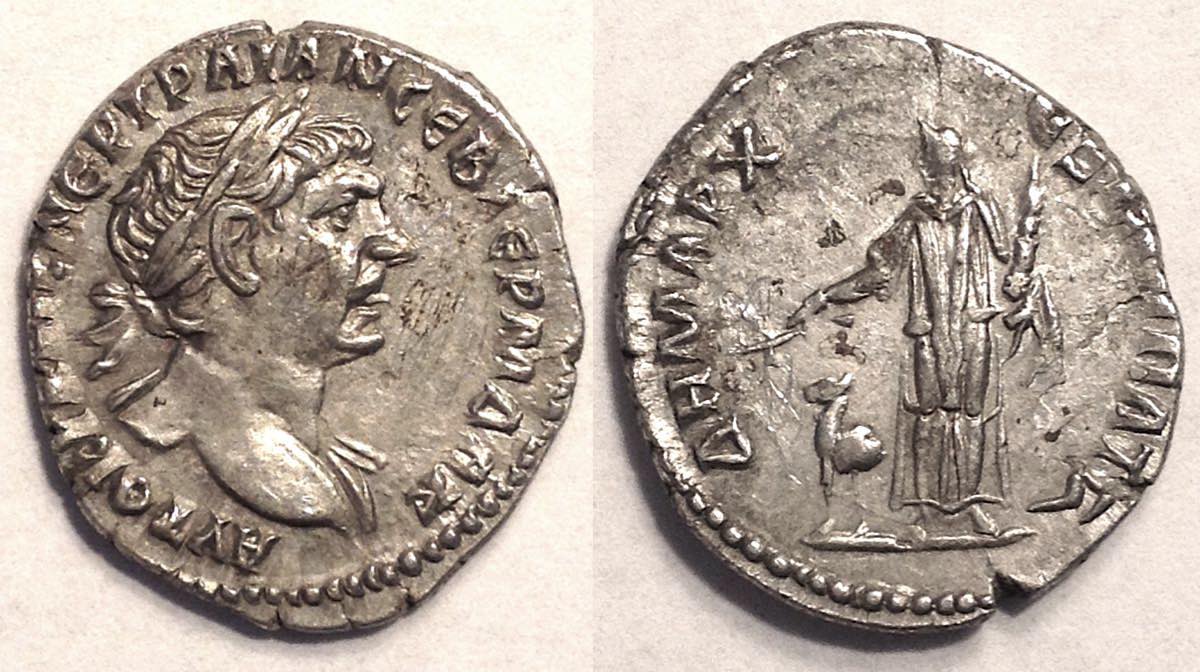 Trajan. Struck 112-114 at Bostra, the capitol of Arabia.
Drachm. 20-18 mm. 3.42 grams.
AVTOP KAIC NЄP TRAIANOC CЄB ΓЄRM ΔAK
Trajan. Struck 112-114 at Bostra, the capitol of Arabia.
Drachm. 20-18 mm. 3.42 grams.
AVTOP KAIC NЄP TRAIANOC CЄB ΓЄRM ΔAK
Laureate head right with slight drapery on far shoulder.
ΔHMAPX ЄΞ IS YΠAT C
Arabia standing left holding out branch in right and bundle of cinnamon sticks (or "canes") in left, forepart of camel below to left.
RPC III 4174
The dies are so Roman-looking that long ago some authors thought they might have been minted in Rome for distribution in Arabia. But Metcalf found several overstruck on Nabaetean coins, which shows this type was minted in the east. Perhaps the dies were engraved in Rome and shipped east, or maybe a Roman engraver was employed in Bostra.
Parthian War. A separate page is devoted to Trajan's coins related to his Parthian war.
Conclusion. This is just a sample of the many interesting historical types of Trajan, the second of Gibbon's "five good emperors."
Go to Trajan's coins related to his Parthian war.
References (in approximate order of usefulness):
Foss, Clive. Roman Historical Coins. HC. A list, with short discussion, of all Roman imperial coin types that refer to particular historical events. You will want to read more about the events elsewhere, but the list is very useful and illuminating.
Casssius Dio, Roman History. The primary ancient source. Trajan is covered in books 68 and 69.
wikipedia [various articles]
RIC volume II, which includes Trajan.
BMC volume III, which includes Trajan.
RPC = Roman Provincial Coinage, Volume III.
Sear, David. Roman Coins and Their Values, II. HC. 2002. The well-known price guide. It is not complete, but remarkably extensive. Most coins can be found in Sear and those that cannot are highly likely to have something quite similar in Sear.
Metcalf, W. "The Tell Kalak Hoard and Trajan's Arabian mint," ANSMN 20 (1975).
Woytek, Bernhard E. and Kevin Butcher, "The Camel Drachms of Trajan in Context: Old Problems and a New Overstrike," The Numismatic Chronicle Vol. 175 (2015), pp. 117-136 (https://www.jstor.org/stable/43859784).
Hill, Philip V. The Dating and Arrangement of the Undated Coins of Rome, A.D. 98-148. HC. 1970. Not all scholars believe he got all the dates right, but his attempt to assign particular years (instead of date ranges like "114-117") has some logic to it.
Go to Trajan's coins related to his Parthian war.
Go to the main Table of Contents page of this entire educational site.
 Coins of Trajan, Roman emperor 98-117 CE, that relate to particular historical events--especially his conquest of Dacia in 106.
Coins of Trajan, Roman emperor 98-117 CE, that relate to particular historical events--especially his conquest of Dacia in 106. 

 Trajan. Denarius.
Trajan. Denarius.


 Trajan, laureate bust right with slight drapery on shoulders.
Trajan, laureate bust right with slight drapery on shoulders. Trajan, laureate bust right with slight drapery on shoulders
Trajan, laureate bust right with slight drapery on shoulders Trajan, laureate bust right with slight drapery on far shoulder
Trajan, laureate bust right with slight drapery on far shoulder Trajan, laureate bust right with slight drapery on far shoulder
Trajan, laureate bust right with slight drapery on far shoulder
 Trajan as COS V, struck c. 110-114
Trajan as COS V, struck c. 110-114
 Trajan. Struck 112-114 at Bostra, the capitol of Arabia.
Trajan. Struck 112-114 at Bostra, the capitol of Arabia.